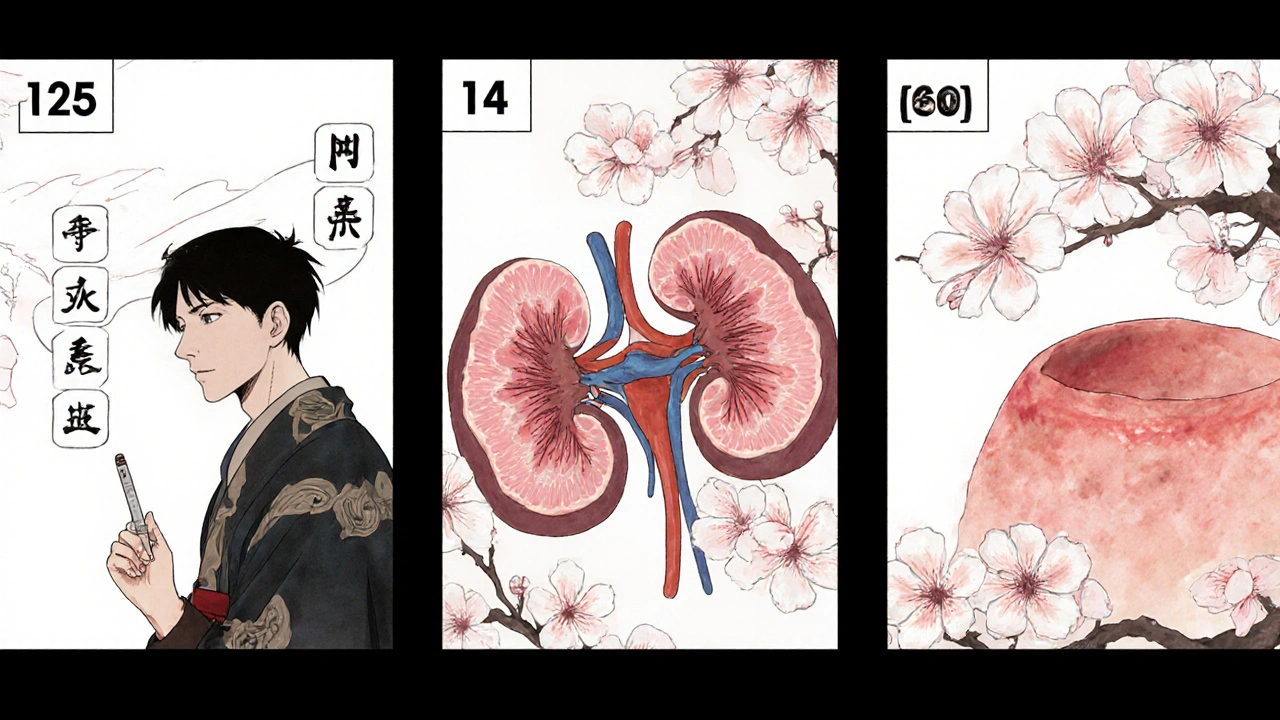Sirolimus Timing Calculator
When a patient gets a kidney transplant, the goal isn’t just to replace the organ-it’s to keep it working for decades. That’s where sirolimus comes in. It’s an immunosuppressant that helps prevent rejection without damaging the new kidney, unlike older drugs like tacrolimus. But there’s a catch: sirolimus can slow down wound healing. For surgeons and transplant teams, this isn’t just a side effect-it’s a timing problem.
Why Sirolimus Slows Healing
Sirolimus, also known as rapamycin, works by blocking a protein called mTOR. This stops immune cells from attacking the transplanted organ. But mTOR isn’t just involved in immunity. It’s also critical for healing. When you cut your skin, your body sends out fibroblasts, endothelial cells, and growth factors to rebuild tissue. Sirolimus shuts down this process. Studies in rats show that when sirolimus is given at therapeutic doses-2.0 to 5.0 mg per kg per day-wound strength drops by up to 40%. Collagen, the scaffold that holds skin together, doesn’t form properly. Blood vessels don’t grow into the wound as they should because sirolimus cuts VEGF (vascular endothelial growth factor) by more than half. VEGF is the signal that tells cells to build new capillaries. No VEGF? No blood flow. No blood flow? No healing. And it’s not just skin. The same thing happens in deeper tissues. In abdominal surgeries, where the incision is large and under tension, the risk of dehiscence-where the wound splits open-is real. Even minor wounds, like those from biopsies or catheter placements, can take weeks longer to close in patients on sirolimus.The Clinical Reality: Not All Wounds Are Equal
Here’s where things get messy. A 2008 study from the Mayo Clinic looked at 26 transplant patients on sirolimus who had dermatologic surgeries-small skin excisions, biopsies, Mohs procedures. Their infection rate was 19.2%, compared to 5.4% in those not on sirolimus. Wound dehiscence happened in 7.7% of the sirolimus group versus 0% in controls. But here’s the kicker: none of those differences were statistically significant. Why? Because the wounds were small. Superficial. Low tension. That’s the key. The risk isn’t the same across all surgeries. A skin biopsy on the arm? Low risk. A liver transplant with a large midline incision? High risk. A hernia repair? Even higher. The location, size, and type of surgery matter more than whether someone is on sirolimus. A 2022 review in Wiley pointed out that early fears about sirolimus and wound healing were based on old data-mostly from high-dose animal studies and early human trials with poor patient selection. Today, we know better. The drug isn’t the villain. It’s the context.When to Start Sirolimus After Surgery
For years, the standard was to wait. Don’t start sirolimus until at least 7 to 14 days after surgery. Some centers waited up to 30 days. The idea was simple: let the wound close first, then add the drug. But that’s changing. New evidence suggests you don’t need to wait that long-if you manage the risks. The American Society of Transplantation updated its guidelines in 2021 to say this: don’t use a one-size-fits-all timeline. Instead, assess the patient. Look at their BMI. Are they diabetic? Do they smoke? Are they malnourished? Those factors matter more than the drug itself. If a patient has a BMI over 30, is a smoker, or has uncontrolled diabetes, delay sirolimus until day 14 or later. But if they’re lean, non-smoking, well-nourished, and had a low-risk procedure? You can start sirolimus as early as day 5-7, as long as you keep their blood levels low-below 4-6 ng/mL. Why low levels? Because wound healing is dose-dependent. At trough levels above 8 ng/mL, complications spike. At 4-6 ng/mL, immunosuppression still works, but healing isn’t crippled. One 2023 study showed that patients kept under 5 ng/mL during the first 30 days had wound complication rates similar to those on calcineurin inhibitors.
Who Should Avoid Sirolimus Altogether?
Not everyone is a candidate. Sirolimus isn’t the first choice for patients with:- High BMI (over 35)
- Active smoking (less than 4 weeks quit)
- Uncontrolled diabetes (HbA1c over 8%)
- Protein-energy malnutrition (serum albumin under 3.0 g/dL)
- History of prior wound dehiscence or poor healing
- Undergoing major abdominal or thoracic surgery
What About Other Drugs?
Sirolimus doesn’t work alone. Most transplant patients get a mix of drugs. Steroids? They delay healing too. Mycophenolate? It can cause poor tissue repair. Antithymocyte globulin? It suppresses healing cells. The real problem isn’t just sirolimus-it’s the combo. Giving sirolimus with high-dose steroids and ATG right after surgery is like pouring gasoline on a fire. That’s why many centers now use a “step-down” approach: start with steroids and calcineurin inhibitors, then swap in sirolimus after 2-4 weeks, once healing is stable.
How to Reduce Risk Before Surgery
You can’t always control the drug, but you can control the patient.- Stop smoking at least 4 weeks before surgery. Smoking cuts blood flow and oxygen delivery to wounds.
- Optimize nutrition. Protein intake should be 1.2-1.5 g per kg of body weight daily. Albumin levels above 3.5 g/dL are ideal.
- Control blood sugar. HbA1c under 7% reduces infection and dehiscence risk.
- Manage weight. Even a 5-10% weight loss before surgery improves healing.
- Use local wound care. Negative pressure wound therapy (NPWT) can help in high-risk cases.
The Bigger Picture: Why Sirolimus Still Matters
Despite the risks, sirolimus is worth keeping in the toolkit. It doesn’t hurt the kidneys. It lowers cancer risk-big time. Transplant patients are 2-5 times more likely to get skin cancer, lymphoma, or Kaposi sarcoma. Sirolimus cuts that risk by up to 50% compared to calcineurin inhibitors. It’s also the go-to drug for patients who develop kidney damage from tacrolimus. Switching to sirolimus can stabilize or even improve long-term graft function. About 15-20% of kidney transplant recipients now take sirolimus long-term. That number is rising. Why? Because we’ve learned how to use it smarter.What’s Next?
Researchers are testing new ways to protect healing while keeping immunosuppression. One trial is looking at intermittent dosing-giving sirolimus every other day during the first 2 weeks. Another is testing topical sirolimus gels for skin wounds to avoid systemic effects. The future isn’t about avoiding sirolimus. It’s about using it at the right time, at the right dose, for the right patient.Can sirolimus cause a surgical wound to open up?
Yes, sirolimus can increase the risk of wound dehiscence, especially in major surgeries like abdominal transplants or hernia repairs. This happens because it blocks cell growth and blood vessel formation needed for healing. The risk is highest in the first week after surgery and in patients with high BMI, diabetes, or who smoke. However, in minor procedures like skin biopsies, the risk is much lower.
How long should I wait after surgery before starting sirolimus?
For low-risk patients-lean, non-smokers, no diabetes, and minor surgery-you can start sirolimus as early as day 5-7. For high-risk patients-obese, diabetic, smokers, or those with major surgery-wait until day 14 or later. Always keep blood levels below 4-6 ng/mL during the first 30 days to balance healing and rejection prevention.
Is sirolimus safer than tacrolimus for wound healing?
No, sirolimus is not safer for wound healing-in fact, it’s more likely to delay healing than tacrolimus. But tacrolimus can damage the transplanted kidney over time. So the choice isn’t about which drug is safer for wounds-it’s about which risk you’re willing to manage. Sirolimus is preferred when kidney protection or cancer prevention is more urgent than immediate wound healing.
Can I still use sirolimus if I’ve had a wound complication before?
It’s possible, but it requires extra caution. If you’ve had a previous wound dehiscence or poor healing, your team will likely delay sirolimus until 6-8 weeks after surgery. They’ll also optimize your nutrition, control blood sugar, and possibly use wound vacuum therapy. Never restart sirolimus without a full risk assessment.
Does sirolimus affect all types of wounds the same way?
No. Large, high-tension wounds-like those from liver or kidney transplants-are most at risk. Small, low-tension wounds-like skin biopsies or minor excisions-are far less affected. Studies show that in dermatologic surgeries, the difference in complication rates between sirolimus users and non-users is often not statistically significant. The type and location of the wound matter more than the drug itself.
What are the signs that sirolimus is affecting my wound healing?
Watch for delayed closure-wounds that aren’t closing after 10-14 days. Other signs include thin, pale tissue around the edges, increased drainage, or signs of infection like redness, warmth, or pus. If your wound isn’t improving after 7 days, or if it starts to widen, contact your surgeon. Blood levels above 8 ng/mL are a red flag.
Sirolimus isn’t a drug you take lightly after surgery. But it’s not a drug you avoid forever either. The key is knowing when to wait, when to start, and how to prepare your body for healing. With the right timing and the right patient, sirolimus can give you a healthy transplant-and a healed wound.

Andrew Baggley
November 20, 2025 AT 04:09Sirolimus isn’t the enemy-it’s just misunderstood. I’ve seen patients on it heal just fine after minor skin procedures. The real issue? Doctors treating everyone like they’re a walking risk. If you’re lean, non-smoker, HbA1c under 6.5? Start it at day 5. No need to wait 30 days like it’s some ancient ritual. We’re not in the 90s anymore.
Frank Dahlmeyer
November 20, 2025 AT 05:07Let me tell you about my cousin who got a kidney transplant last year-on sirolimus from day 7. He’s a marathon runner, 5’10”, 160 lbs, never smoked, diet is clean. His incision? Closed by day 9. No infections. No drama. Meanwhile, his buddy who waited 21 days because the doc was ‘being cautious’? Got a wound infection, ended up in the ER. Timing matters, but so does the patient. Stop treating everyone like they’re one bad biopsy away from disaster. We’ve got data now, not guesswork.
Codie Wagers
November 21, 2025 AT 23:52The entire paradigm of ‘wound healing risk’ is a distraction. What you’re really seeing is the failure of clinical humility. Sirolimus doesn’t ‘delay healing’-it reveals the fragility of the human body under metabolic stress. The drug isn’t the villain; the sedentary, diabetic, obese, nicotine-addicted patient population is. We’ve created a cohort of biological liabilities and then blamed the pharmacology for their poor outcomes. This isn’t a drug problem-it’s a societal one. We medicate poor lifestyle choices instead of fixing them. Sirolimus is just the scalpel that cuts through the illusion.
Paige Lund
November 22, 2025 AT 05:09So… we’re supposed to be impressed that we figured out not to give a drug that slows healing right after cutting someone open? Groundbreaking. Next up: water is wet.
Reema Al-Zaheri
November 23, 2025 AT 16:13It is critical to recognize that the dose-dependency of sirolimus on wound healing is not merely anecdotal; it is empirically validated across multiple prospective cohorts. Furthermore, the concomitant use of corticosteroids, mycophenolate, and antithymocyte globulin significantly exacerbates the risk-this is not a monotherapy issue; it is a polypharmacy crisis. Therefore, the step-down protocol is not merely advisable-it is mandatory in high-risk scenarios.
Michael Salmon
November 24, 2025 AT 11:20Everyone’s acting like sirolimus is the new villain, but let’s be real: tacrolimus is slowly killing transplants with nephrotoxicity. Sirolimus is the lesser evil-and we know it. But no one wants to admit that we’re trading one problem for another. We’re just pretending we’ve solved it by tweaking the start date. We haven’t. We’ve just delayed the inevitable. The real solution? A new drug. Not a schedule.
Joe Durham
November 25, 2025 AT 07:48I appreciate how nuanced this is. I’ve had patients who needed sirolimus for cancer prevention but had terrible wound healing histories. We ended up doing a hybrid approach: started low-dose sirolimus at day 7, kept levels under 5 ng/mL, added NPWT, and had a nutritionist on board daily. It worked. Not because we followed a rule, but because we treated the person-not the protocol. The guidelines are a start, but the art is in the adaptation.
seamus moginie
November 25, 2025 AT 13:02Sirolimus is a tool, not a trap. Use it wisely.